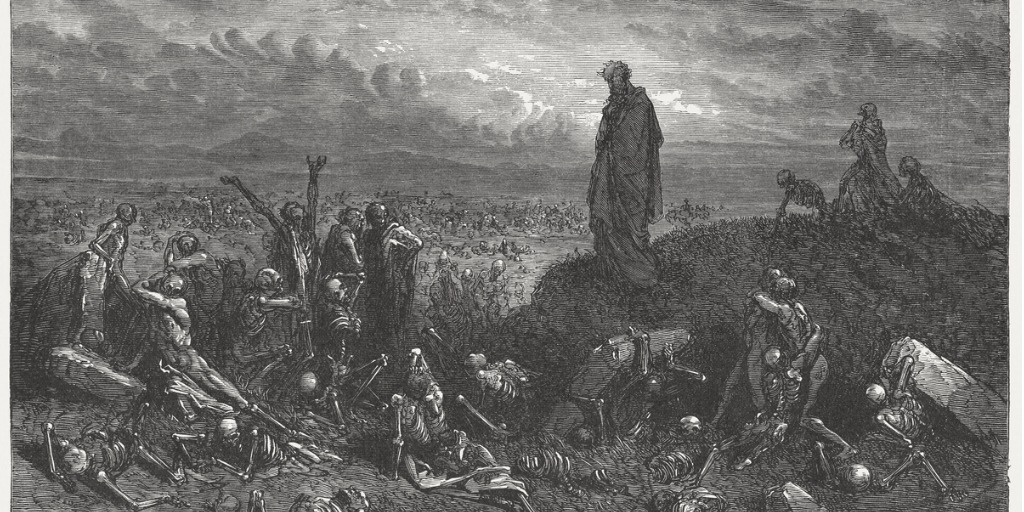Bible Version: New International Version (NIV)
Application Notes: Life Application Study Bible (NIV)
EZEKIEL 1
Ezekiel’s Inaugural Vision
1 In my thirtieth year, in the fourth month on the fifth day, while I was among the exiles by the Kebar River, the heavens were opened and I saw visions of God.
2 On the fifth of the month—it was the fifth year of the exile of King Jehoiachin— 3 the word of the Lord came to Ezekiel the priest, the son of Buzi, by the Kebar River in the land of the Babylonians. There the hand of the Lord was on him.
4 I looked, and I saw a windstorm coming out of the north—an immense cloud with flashing lightning and surrounded by brilliant light. The center of the fire looked like glowing metal, 5 and in the fire was what looked like four living creatures. In appearance their form was human, 6but each of them had four faces and four wings. 7 Their legs were straight; their feet were like those of a calf and gleamed like burnished bronze. 8 Under their wings on their four sides they had human hands. All four of them had faces and wings, 9 and the wings of one touched the wings of another. Each one went straight ahead; they did not turn as they moved.
10 Their faces looked like this: Each of the four had the face of a human being, and on the right side each had the face of a lion, and on the left the face of an ox; each also had the face of an eagle. 11 Such were their faces. They each had two wings spreading out upward, each wing touching that of the creature on either side; and each had two other wings covering its body. 12 Each one went straight ahead. Wherever the spirit would go, they would go, without turning as they went. 13 The appearance of the living creatures was like burning coals of fire or like torches. Fire moved back and forth among the creatures; it was bright, and lightning flashed out of it. 14 The creatures sped back and forth like flashes of lightning.
15 As I looked at the living creatures, I saw a wheel on the ground beside each creature with its four faces. 16 This was the appearance and structure of the wheels: They sparkled like topaz, and all four looked alike. Each appeared to be made like a wheel intersecting a wheel. 17 As they moved, they would go in any one of the four directions the creatures faced; the wheels did not change direction as the creatures went. 18 Their rims were high and awesome, and all four rims were full of eyes all around.
19 When the living creatures moved, the wheels beside them moved; and when the living creatures rose from the ground, the wheels also rose. 20 Wherever the spirit would go, they would go, and the wheels would rise along with them, because the spirit of the living creatures was in the wheels. 21 When the creatures moved, they also moved; when the creatures stood still, they also stood still; and when the creatures rose from the ground, the wheels rose along with them, because the spirit of the living creatures was in the wheels.
22 Spread out above the heads of the living creatures was what looked something like a vault, sparkling like crystal, and awesome. 23 Under the vault their wings were stretched out one toward the other, and each had two wings covering its body. 24 When the creatures moved, I heard the sound of their wings, like the roar of rushing waters, like the voice of the Almighty, like the tumult of an army. When they stood still, they lowered their wings.
25 Then there came a voice from above the vault over their heads as they stood with lowered wings. 26 Above the vault over their heads was what looked like a throne of lapis lazuli, and high above on the throne was a figure like that of a man. 27 I saw that from what appeared to be his waist up he looked like glowing metal, as if full of fire, and that from there down he looked like fire; and brilliant light surrounded him. 28 Like the appearance of a rainbow in the clouds on a rainy day, so was the radiance around him.
This was the appearance of the likeness of the glory of the Lord. When I saw it, I fell facedown, and I heard the voice of one speaking.
Application Notes
1:1 Ezekiel, born and raised in the land of Judah, was preparing to become a priest in God's temple when the Babylonians attacked in 597 BC and carried him away, along with 10,000 other captives (2 Kings 24:10-14). His nation was on the brink of complete destruction. Four or five years later, when Ezekiel was 30 (the normal age for becoming a priest}, God called him to be a prophet. During the first six years of Ezekiel's prophetic ministry in Babylonia, also known as the “land of the Chaldeans” (Ezekiel 1:3), Jeremiah was preaching to the Jews who were still in Judah prior to Jerusalem's destruction, and Daniel was serving as an official in Nebuchadnezzar's court. The Kebar River flowed into the Euphrates River in Babylonia, and along its banks there was a large settlement of Jewish exiles.
1:1 Why did the Jewish exiles in Babylonia need a prophet? God wanted Ezekiel to (1) help the exiles understand why they had been taken captive, (2) dispel the false hope that the captivity was going to be short, (3) bring a new message of hope, (4) call the people to a new awareness of their dependence upon God, and (5) prophesy a new day of redemption with a new covenant.
1:1 God communicated to Ezekiel in visions. A vision is a miraculous revelation of a message God gives to a person to pass on to others. Unlike a dream, a person doesn't have to be sleeping to receive a vision from God. The visions Ezekiel received seem strange to us because they are apocalyptic, meaning that they contain symbolic pictures that vividly convey ideas. Daniel and John were other Bible writers who used apocalyptic imagery based on their visions from God. The people in exile had lost their perspective of God's purpose and presence, and Ezekiel came to them with a fresh vision from God to show God's awesome glory and holiness and to warn the exiles of sin's consequences before it was too late.
1:1 Ezekiel's latest dated message from God (29:17) was given in 571 BC. He had been taken captive during the second Babylonian invasion of Judah in 597. The Babylonians invaded Judah a third and final time in 586, completely destroying Jerusalem, burning the temple, and deporting the rest of the people (see 2 Kings 25). Ezekiel dates all his messages from the year he was taken captive (597). His first prophecy to the exiles occurred four or five years after he arrived in Babylonia (593).
1:3 Ezekiel's name means “God is strong” or “God strengthens.” In a very real sense, this sums up the basic message of Ezekiel's book—that in spite of the Captivity, God's sovereign strength always prevails, and he will judge his enemies and restore his true people.
1:4-28 In this first vision, God called Ezekiel to be a prophet (see 2:5). Nothing in Ezekiel's previous experience had prepared him for such a display of God's glorious presence and power. The great windstorm from the north was a symbol of the great armies of Babylon approaching Jerusalem as God's instrument of judgment upon the nation of Judah. The immense cloud flashed with lightning and was surrounded by a brilliant light. From within the fire in the cloud came four living creatures. They showed Ezekiel that Jerusalem's coming destruction was God's punishment of Judah for its sins. (These living creatures are also pictured in Revelation 4:6-7.)
When Ezekiel received this vision in Babylon, he was far away from the temple in Jerusalem, the physical symbol of God's presence and covenant relationship with his people. At this time, God's presence dwelled among his people in the temple in a special way. Through this vision, however, Ezekiel learned that God is present everywhere—he was even with the exiles in Babylon—and that God's activities in heaven are shaping the events on earth.
1:5-12 Each of the four living creatures had four faces, symbolizing God's completeness. Some believe that the lion represented strength; the ox, diligent service; the man, intelligence; and the eagle, divinity. Others see these as the most majestic of God's creatures and say that they therefore represented God's whole creation. The early church fathers saw a connection between these beings and the four Gospels: the lion with Matthew, representing Christ as the Lion of Judah; the ox with Mark portraying Christ as the servant; the man with Luke, portraying Christ as the perfect human; and the eagle with John, portraying Christ as the Son of God, exalted and divine. John's vision recorded in Revelation 4 parallels Ezekiel's vision.
1:16-18 The “wheel intersecting a wheel” is probably a description of two wheels at right angles to each other, one on a north-south axis and the other on an east-west axis. Able to move in any direction, these wheels show that God is present everywhere and can see all things (1:18). God rules not only Jerusalem but all of life and history. The exiles had experienced great disruption, but God still controlled their future no matter what they faced.
1:22-25 The vault showed the separation of God from the creatures (see Revelation 4:6). God's holiness sets him completely apart, so anyone who is not holy must remain a distance away from him. No one can see God and live (Exodus 33:20). Ezekiel could not see God directly, only his glory. One day, those who follow Jesus will see him face-to-face (1 John 3:2; 4:17).
1:26 This “figure like that of a man” revealed God's presence and prepared Ezekiel for what God was about to tell him. The figure represented God himself on the throne in all his holiness and glory. In a similar way, Jesus revealed God in human form and prepared us for his message of salvation. Jesus came into history in a real, human body. When Jesus returns in shining glory, he will comfort all who have trusted in him but terrify those who have rejected him. Lapis lazuli is a semiprecious gemstone that has a rich azure-blue color. (For more on lapis lazuli, see 10:1 and Exodus 24:10.)
1:27-28 To Ezekiel the glory of the Lord appeared like fire and a glowing rainbow or halo of brilliant light. God's glory is his all-surpassing power and brilliance. He shimmers with life, beauty, power, energy, and creativity. Ezekiel fell face down, overwhelmed by the contrast between God's holiness and his own sinfulness and insignificance. Eventually every person will fall before God, either out of reverence and awe for his mercy or out of fear of his judgment. Based on the way you are living today, how Will you respond to God's holiness? (See Isaiah 45:23; Romans 14:11; and Philippians 2:10 for more on bowing bet ore God.)
1:27-28 The four living creatures and the four wheels are powerful
pictures of judgment, yet the rainbow over the throne symbolizes God’s never-ending faithfulness to his people. Just as God sent a rainbow to Noah to symbolize his promise never again to destroy the earth with a flood (Genesis 9:8-17), this rainbow symbolizes his promise to preserve those who remain faithful to him. If God did not save us, we would be lost forever. The purpose of God's judgment is to correct us and, ultimately, to allow perfect peace and righteousness to reign on the earth forever.
Taken from Life Application Study Bible - Third Edition - (NIV)

